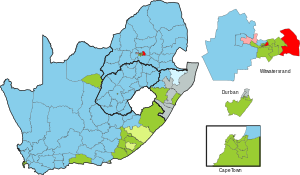This article needs additional citations for verification. (December 2009) |
| |||||||||||||||||||||||||||||
All 121 seats in the House of Assembly 61 seats needed for a majority | |||||||||||||||||||||||||||||
|---|---|---|---|---|---|---|---|---|---|---|---|---|---|---|---|---|---|---|---|---|---|---|---|---|---|---|---|---|---|
| |||||||||||||||||||||||||||||
| |||||||||||||||||||||||||||||
| This article is part of a series on the |
| Politics of South Africa |
|---|
 |
|
|
General elections were held in South Africa on 15 September 1910 to elect the 121 members of the House of Assembly. They were the first general election after the Union of South Africa was created on 31 May 1910.
The elections were held alongside the first election to the provincial councils of Cape Province and Transvaal. Those councils used the same electoral districts as those for the House of Assembly seats in the province. The first election for the provincial councils of Natal and Orange Free State, which did not use the same constituency boundaries as the House of Assembly, took place at a later date.[1]
Although the Unionist Party received the most votes, the alliance of parties led by General Louis Botha won a slim majority. The Unionist Party became the official opposition. Botha's alliance would later unite as the South African Party.
- ^ The Times, edition of 26 July 1910 reports the fixing of the election dates




